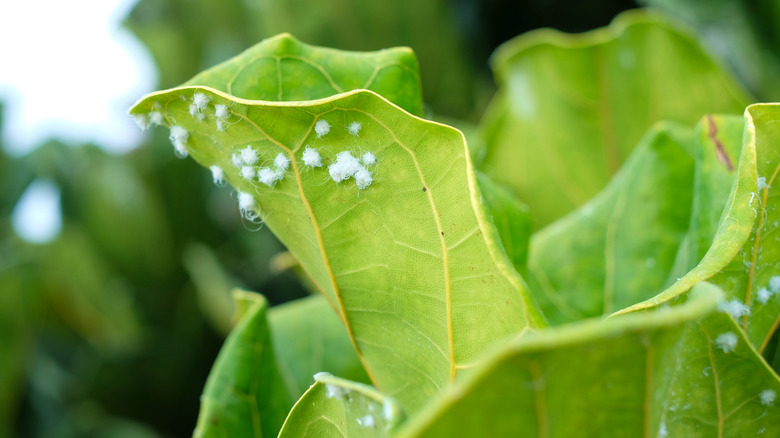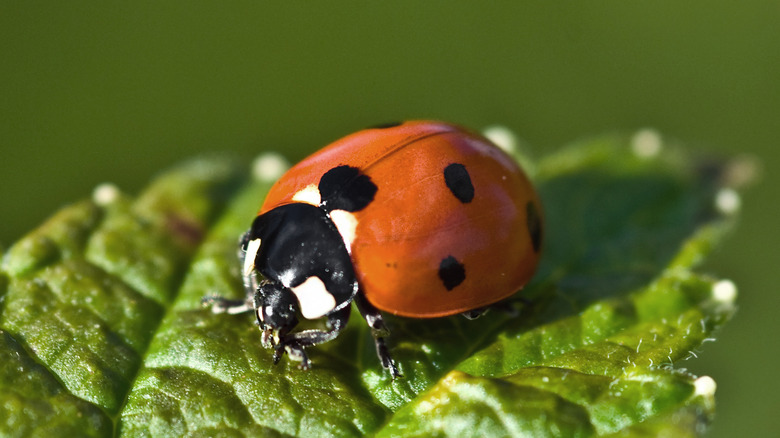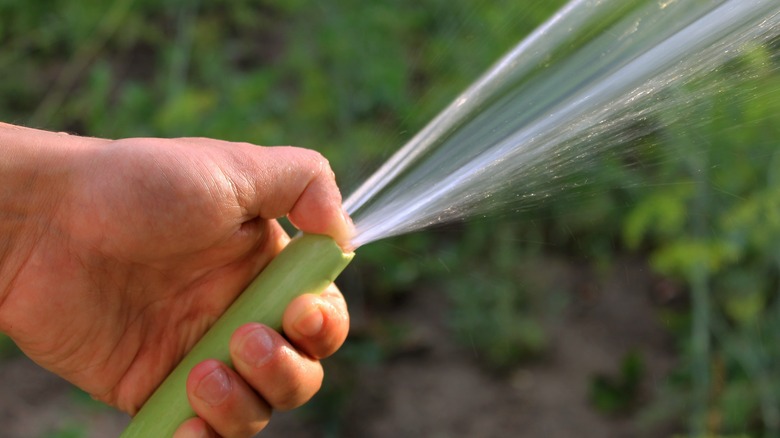How To Keep Woolly Aphids Out Of Your Garden
Whether you're a new or experienced gardener, flourishing plants in beautiful gardens are destined to attract unwanted guests — including woolly aphids, also known as Eriosomatinae. If you're unlucky enough to have encountered them, you may know that aphids have pear-shaped bodies, six legs, and a pair of horned tubes called cornicles sticking out of their lower back. Some, but not all, also grow wings in adulthood. While there are thousands of aphid species throughout the world, the woolly aphid is unique in presentation, utilizing wax secretions, which many describe as having a cotton or threadlike appearance, to coat their bodies.
Woolly aphids may not be invasive in North America, per the Center for Invasive Species and Ecosystem Health, but they can still cause trouble. These bugs live off of sap they suck out of plants and trees, and they often secrete excess nutrients in the form of honeydew (not the melon) in addition to that waxy coating. This is where your problems may arise: Their sap-sucking can deprive and damage your plants, and the sticky residue can be detrimental to a healthy garden, especially if it develops mold. So once you identify the insects — and what they leave behind — it's important to devise a solid plan to keep them away from your thriving plants.
Preventing the problem
If you've caught this potential problem before you see it taking over your garden, you're in luck. Preventative measures are your best bet, as there are multiple ways to divert woolly aphids before they really set in.
These insects have quite a few natural predators including parasitic wasps, lacewings, and ladybugs. Predators have a knack for hunting down their prey on their own, but you can do your part in protecting your crops by adding plants that attract those "good insects" to your yard and garden. For example, ladybugs gravitate toward flat-topped flowers and any blooms bursting with pollen. These insects and plants are not only beneficial for removing woolly aphids, but they also directly help your garden in their own right: More variation in plants and pollinators leads to a healthier, happier garden overall.
Utilizing acephate and other woolly aphid insecticides is another option. However, this is a more drastic measure that isn't recommended unless absolutely necessary, since natural remedies prove to be much safer alternatives for your garden as a whole than harsh chemicals.
Removing woolly aphids from your garden
As mentioned earlier, these insects aren't invasive, but any gardener knows that it's quite alarming to see an unexpected (and unwelcome) guest roaming throughout their garden, especially when their presence could harm the plants residing there. The best method for each pest varies, but luckily, there are a handful of simple tricks to remove woolly aphids quickly — and without getting any harmful chemicals involved – if you've already found them taking hold.
First, you can try to remove them yourself by catching the insects and releasing them elsewhere, allowing them to relocate away from your flourishing greenery. This method isn't foolproof, however, so you can also spray water on the areas where the insects have taken over. Whether it's the honeydew and waxy secretions or clumps of the insects themselves, a quick spray should do the trick while simultaneously watering your plants. In the worst cases, you might have to prune away the worst-off victims of the infestation.
Again, it's ideal if you don't have to use harsh chemicals on your crop and can let nature do its work instead. And after removing the pests, especially if you had to resort to chemical means, it may be a good time to invest in some of those predator-enticing plants if you haven't already. This way, if the woolly aphids do return, you have a natural front line of defense protecting your garden.


